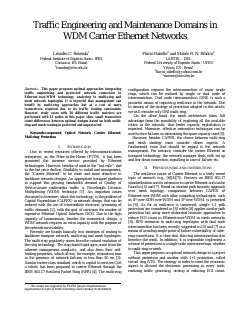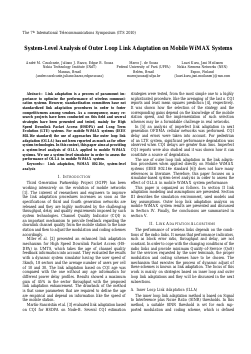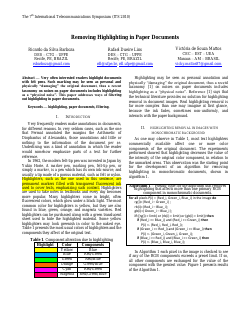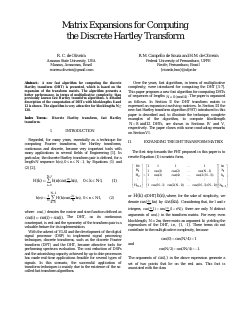
VII International Telecommunications Symposium

Depth Map Discontinuity Correction for 3D Video Systems
Camilo Dorea, Ricardo L. de Queiroz ´
DOI: 10.14209/sbrt.2010.85
Keywords: depth map correction multiview video image segmentation
Abstract
Inaccurate depth map discontinuities are an important source of artifact and distortion in multiview systems and applications requiring depth-based view rendering such as 3DTV or free-viewpoint video. Such errors along depth discontinuities frequently occur during depth estimation and/or depth map coding. In this paper we present a novel method for correcting inaccuracies on the discontinuities along object borders within depth maps using color features available within the associated view. Erroneous depth map border areas are split into a set of fine, color-homogeneous regions and a region merging technique is used to form new depth map borders in conformance with the available color cues. The proposed algorithm can align depth discontinuities to object borders using only information within a single view. Results demonstrate the effectiveness of our method on multiview video-plus-depth test images.Download

On the Effectiveness of Dynamic Spectrum Management Algorithms in xDSL Networks
Fernanda Smith, Evaldo Pelaes, Marcio Monteiro, Boris Dortschy, Francisco Muller, Aldebaro Klautau
DOI: 10.14209/sbrt.2010.122
Keywords: Dynamic spectral management digital subscriber line discrete multitone modulation
Abstract
This work proposes a method for the evaluation of the effectiveness of adopting dynamic spectral management (DSM) algorithms in different DSL scenarios. In the last years several DSM algorithms emerged in the literature but their comparison has been typically conducted within few scenarios and considering specific operating points. This work proposes the adoption of the DSM effectiveness factor (DEF) as a figure of merit capable of comparing the volumes of the whole rate regions, which expresses the set of operating points in the Pareto front. A random scenario generator was used to obtain four hundred DSL scenarios and compared flat power backoff (PBO) and DSM algorithms of levels 1 and 2. Besides confirming well-known facts, such that the effectiveness of DSM is significant in near-far scenarios, the results based on the proposed DEF allow to quantify the gains in bit rate that DSM can bring.Download

Blind Source Separation in Polarization Division Multiplexed Optical Systems
E. S. Rosa, E. Z. Nadalin, J. M. T. Romano, R. Suyama
DOI: 10.14209/sbrt.2010.87
Keywords: Polarization division multiplexed optical systems blind source separation independent component analysis
Abstract
Polarization division multiplexing systems is a promising technique, able to double the capacity of next generation optical communication systems. However, the most common employed algorithms to recover the sources from the received data have the drawback of losing sources when polarization dependent loss is present. To tackle this problem, we propose different approaches based on independent component analysis algorithms.Download

Traffic Engineering and Maintenance Domains in WDM Carrier Ethernet Networks
Leandro C. Resendo, Flávio Rabello, Moisés R. N. Ribeiro
DOI: 10.14209/sbrt.2010.80
Keywords: Optical Network Carrier Ethernet Muli-ring Protection
Abstract
This paper proposes optimal approaches integrating traffic engineering and protected network connection in Ethernet-over-WDM technology, analyzing to multi-ring and mesh network topologies. It is expected that management can benefit by multi-ring approaches but at a cost of more transceivers required due to its traffic routing constraints. However, study cases with 20 different traffic matrices are performed with 13 nodes in this paper show small transceiver count differences between optimal designs based on both multiring and mesh routing in protected and unprotected.Download

Geographic Routing in IEEE 802.11 Wireless Networks with Channel Width Adaptation
Celso Barbosa Carvalho, José Ferreira de Rezende
DOI: 10.14209/sbrt.2010.81
Keywords: Geographic Routing Software Defined Radio IEEE 802.11 Channel Width Adaptation Routing Metric
Abstract
n this paper, we propose two geographic routing metrics applied to wireless mesh networks that consider the use of channel width adaptation. The proposed metrics are evaluated through simulations jointly with a next hop channel width selection algorithm. The results show that the proposed metrics and algorithm generate greater throughput values when compared with existing geographic routing metrics.Download

System-Level Analysis of Outer Loop Link Adaptation on Mobile WiMAX Systems
Andre M. Cavalcante, Juliano J. Bazzo, Edgar B. Souza, Marco J. de Sousa, Lauri Kuru, Jani Moilanen
DOI: 10.14209/sbrt.2010.86
Keywords: Link adaptation WiMAX 802.16e system-level analysis
Abstract
Link adaptation is a process of paramount importance to optimize the performance of wireless communication systems. However, standardization committees have not standardized link adaptation procedures in order to foster competitiveness among vendors. As a consequence, many research projects have been conducted on this field and several strategies have been presented and tested, mainly for High Speed Downlink Packet Access (HSDPA) and Long Term Evolution (LTE) systems. For mobile WiMAX systems (IEEE 802.16e standard) the use of approaches like outer loop link adaptation (OLLA) has not been reported as much as for other system technologies. In this context, this paper aims at providing a system-level analysis of OLLA applied to mobile WiMAX systems. We use a system-level simulator in order to assess the performance of OLLA in mobile WiMAX system.Download

SUI Propagation Model Tuning from Collected Data in Fixed Wireless Systems at Arboreous Environments on 5.8 GHz Band
Bruno S. L. Castro, Gervásio P. S. Cavalcante, Igor R. Gomes, Oziel de O. Carneiro
DOI: 10.14209/sbrt.2010.123
Keywords: SUI Model least squares tuning algorithm 5.8 GHz arboreous environments
Abstract
This paper presents an tuning in SUI Propagation Model through the least squares algorithm. Data measurements were carried out in arboreous environments, in 12 amazon region cities containing broadband wireless networks on 5.8 GHz. The RMS error and standard deviation have been used as evaluation metrics. The results have shown a good agreement of the tuned SUI model to the measured data.Download

Acoustic Water Leak Detection System
Liselene de Abreu Borges, Miguel Arjona Ramírez
DOI: 10.14209/sbrt.2010.21
Keywords: Water Leak Detection SVM AR PCA
Abstract
This article presents an acoustic water leak detection system. It shows all the stages for doing acoustic leak signal processing and classification. The technique used for classification is support vector machine (SVM) using as features the Itakura mean and maximum distance and the larger projection of the principal component analysis (PCA). The whole process is based on the autoregressive (AR) models of the signals. Detection rate achieved is 80%.Download

Removing Highlighting in Paper Documents
Ricardo da Silva Barboza, Rafael Dueire Lins, Victória de Souza Mattos
DOI: 10.14209/sbrt.2010.88
Keywords: highlighting paper documents filtering
Abstract
Very often interested readers highlight documents with felt pens. Such marking may be seen as personal and physically “damaging” the original document, thus a recent taxonomy on noises on paper documents includes highlighting as a “physical noise”. This paper addresses ways of filtering out highlighting in paper documents.Download

Matrix Expansions for Computing the Discrete Hartley Transform
R. C. de Oliveira, R.M. Campello de Souza, H.M. de Oliveira
DOI: 10.14209/sbrt.2010.89
Keywords: Discrete Hartley transform fast Hartley transform
Abstract
A new fast algorithm for computing the discrete Hartley transform (DHT) is presented, which is based on the expansion of the transform matrix. The algorithm presents a better performance, in terms of multiplicative complexity, than previously known fast Hartley transform algorithms. A detailed description of the computation of DHTs with blocklengths 8 and 12 is shown. The algorithm is very attractive for blocklengths N ≥ 128.Download